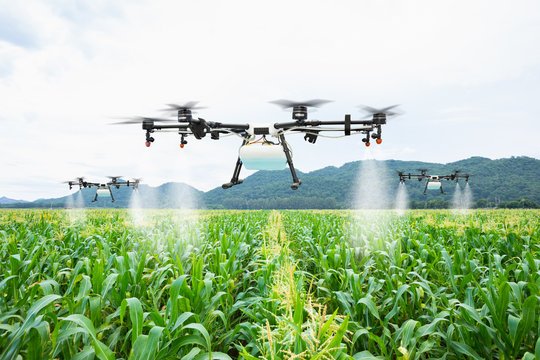Wednesday, 12 November 2025


In an exclusive interview with AgroSpectrum, Agnishwar Jayaprakash, Founder and CEO of Garuda Aerospace, outlined the company’s ambitious global roadmap across the USA, Australia, and the Middle East, emphasizing region-specific drone applications and a localized go-to-market strategy. The Garuda Kisan Drone, India’s flagship agri-UAV, is positioned as a cost-effective, AI-driven solution for high-scale agriculture in the U.S. Corn Belt and Australian wheat zones. Jayaprakash highlighted that a convergence of favorable global regulations, proven domestic deployments, and marquee partnerships with Lockheed Martin, Elbit, and Thales catalyzed the company’s international foray. Garuda’s model balances mass-market disruption in agri-tech with precision innovation in defense, powered by modular hardware, AI analytics, and bundled services. He credited India’s liberalized drone rules and PLI scheme for enabling scale and global credibility, while calling for Drone Export Zones and deeper supply chain incentives to achieve 10x export growth. Looking ahead to 2030, Garuda envisions becoming the world’s most trusted drone brand—training over a million pilots and transforming drones into indispensable productivity tools.
The USA, Australia, and the Middle East are very different markets in terms of regulation, use-cases, and competitive landscapes. How will Garuda tailor its go-to-market strategy across these geographies?
At Garuda Aerospace, our international go-to-market strategy is deeply localized and driven by regulatory alignment, sector-specific innovation, and strategic collaborations. Whether it’s enabling precision agriculture in the U.S.A., addressing labor in Australia’s agritech sector, or supporting infrastructure surveillance in the Middle East, we adapt our UAV platforms and services to solve region-specific challenges. Our approach combines advanced drone technology, AI integration, and flexible deployment models—ensuring we deliver measurable value across diverse regulatory and operational landscapes.
With the Garuda Kisan Drone leading your export push, how do you envision India’s agricultural drone innovation solving problems in the US corn belt or Australian wheat zones ?
The Garuda Kisan Drone is a testament to India’s frugal yet advanced agri-tech innovation. Designed for versatility and resilience, it offers high-precision capabilities at a competitive cost—making it ideally suited for large-scale operations in the U.S.A and Australia regions. By combining AI-powered insights, multispectral imaging, and autonomous flight systems, our drones empower farmers to enhance yield, optimize inputs, and address labor challenges—bringing scalable transformation to global agriculture.
What gave you the confidence that now is the right time to go global? Were there specific signals—market readiness, technology maturity, or policy alignment—that catalyzed this move?
Our global expansion is driven by a convergence of policy clarity, technological maturity, and rising global demand for trusted drone alternatives. With regulatory frameworks evolving across key markets, and our UAV platforms proven through many successful missions in India. The momentum from strategic partnerships, PLI recognition, and international interest made it evident—this is the right time for an Indian aerospace player to scale globally with confidence
What makes Garuda’s drones globally competitive—from a tech, cost, or serviceability standpoint? Are you betting on hardware, AI-driven analytics, or bundled service models?
Garuda’s strength lies in delivering rugged, intelligent, and serviceable drone solutions that are globally competitive across sectors. Our modular hardware, AI-powered analytics, and full-stack service ecosystem provide clients with more than just a drone—we offer actionable insights, operational reliability, and end-to-end support. By combining affordability with advanced autonomy and post-mission intelligence, we’re enabling scalable UAV adoption in agriculture, infrastructure, and defense worldwide
Several Western drone players focus on enterprise software or niche defense applications. How does Garuda position itself in this mix—are you a mass-market disruptor or a precision niche player?
Garuda Aerospace uniquely blends scale with specialization. We’re disrupting mass markets like agriculture and civic infrastructure by making drone technology accessible, intelligent, and affordable. At the same time, we operate as a precision partner in defense and enterprise segments—delivering mission-specific UAV solutions through co-development and innovation. This hybrid model allows us to democratize drone adoption while pushing the boundaries of what unmanned systems can achieve.
You’ve partnered with global majors like Lockheed Martin, Elbit Systems, and Thales. Can you share how these collaborations are shaping product development or market entry?
Our collaborations with global leaders like Lockheed Martin, Elbit Systems, and Thales reflect both a vote of confidence in Garuda’s capabilities and a shared vision for next-generation aerospace innovation. These partnerships enable advanced co-development—from ISR systems to avionics—and crucially, open doors to high-trust defense and government markets. Together, we’re not just building technology—we’re aligning with NATO-grade quality standards and accelerating India’s emergence as a credible global player in the drone and aerospace ecosystem.
Will Garuda follow an asset-light export model—via licensing or JVs—or are you considering setting up local assembly or service facilities abroad?
Garuda’s global expansion follows a hybrid model tailored to regional dynamics. In developed markets, we adopt an asset-light approach—leveraging licensing, joint ventures, and white-labeling with trusted partners to scale efficiently. Complementing both models, our certified service and training centers ensure consistent quality, operational readiness, and local capacity building worldwide.
How has India’s evolving drone policy—especially the liberalized Drone Rules and PLI scheme—enabled Garuda to scale and attract international attention?
India’s progressive drone policy reforms and the PLI scheme have been instrumental in Garuda’s growth journey. The liberalized Drone Rules simplified operations, allowing us to scale rapidly across the country, while the PLI recognition positioned us as a trusted national player. Government-led initiatives like SVAMITVA and Namo Drone Didi created robust domestic demand, helping us prove our technology at scale. This strong policy and market foundation has significantly boosted our global credibility, attracting international partners and investors.
Do you believe India can become a net drone exporter by 2030? What gaps still exist in testing, component supply chains, or funding?
India has strong potential to become a net drone exporter by 2030, supported by a vibrant talent pool and enabling policies. However, realizing this vision requires a holistic strengthening of the ecosystem—especially in localizing critical components like high-efficiency motors, flight controllers, and advanced sensors. The establishment of national test corridors and standardized frameworks for BVLOS operations will also be key. Additionally, increased availability of patient capital and stronger public-private partnerships will accelerate the maturation of India’s drone manufacturing and supply chain capabilities
As a founder-CEO, what’s your ask from the Government of India today? What would unlock the next 10x for drone exports?
To unlock the next 10x growth in drone exports, we urge the Government of India to establish dedicated Drone Export Acceleration Zones that integrate customs, certification, and logistics near ports. Expanding the PLI scheme to sub-component manufacturers and incentivizing aerospace clusters will strengthen domestic supply chains. These initiatives will drive job creation, boost manufacturing, and firmly establish India as the global drone factory.
Looking ahead, what does success look like for Garuda in 2030? Are you chasing valuation milestones, country counts, or a deeper mission?
For Garuda, success by 2030 goes beyond valuations or market presence. It’s about creating meaningful impact—being active countries, training a million drone pilots, and becoming the most trusted brand in agriculture, infrastructure, and defense. Our mission is to make drones indispensable daily tools that enhance productivity, improve safety, and contribute to global sustainability. This is the legacy we strive to build. We are building not just a company but a movement—of dronepreneurs, technocrats, and innovators who believe in India’s ability to lead the next era of aerospace.
—- Suchetana Choudhury (suchetana.choudhuri@agrospectrumindia.com)